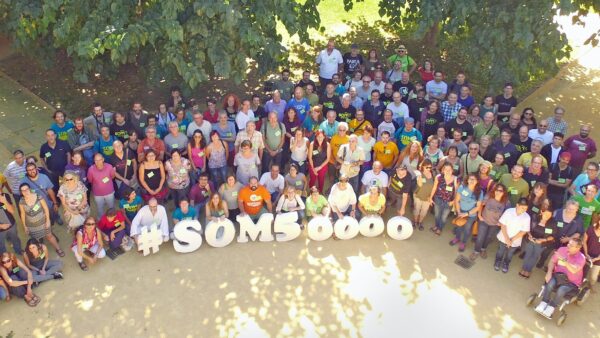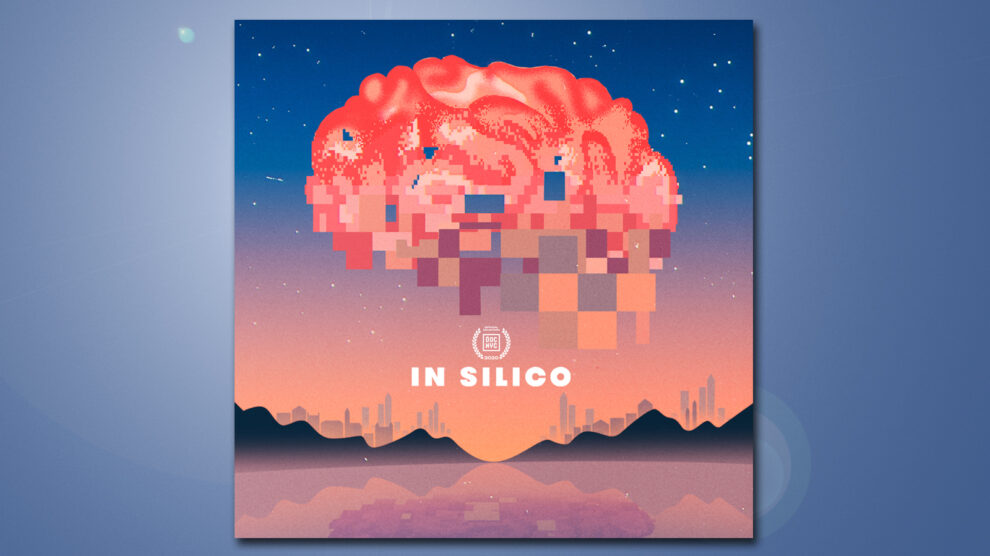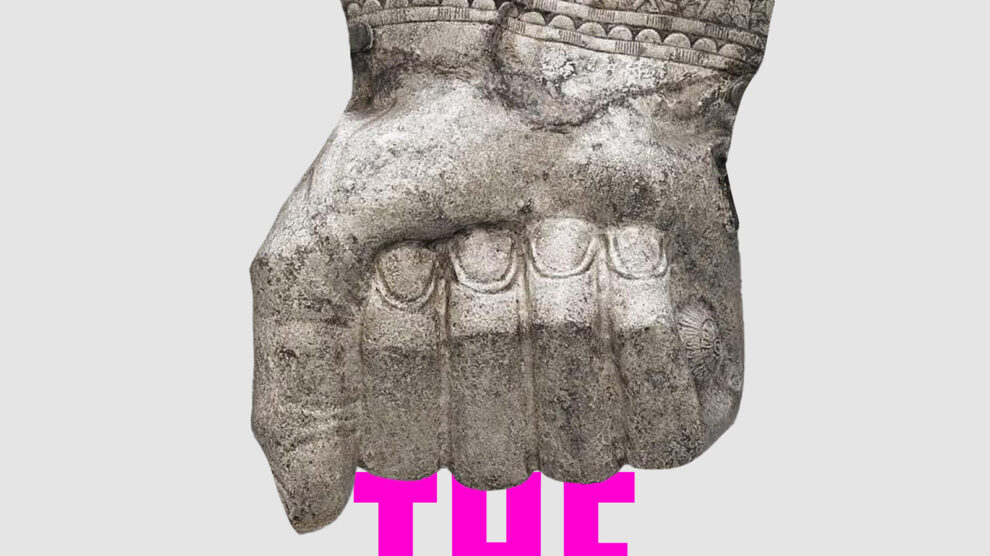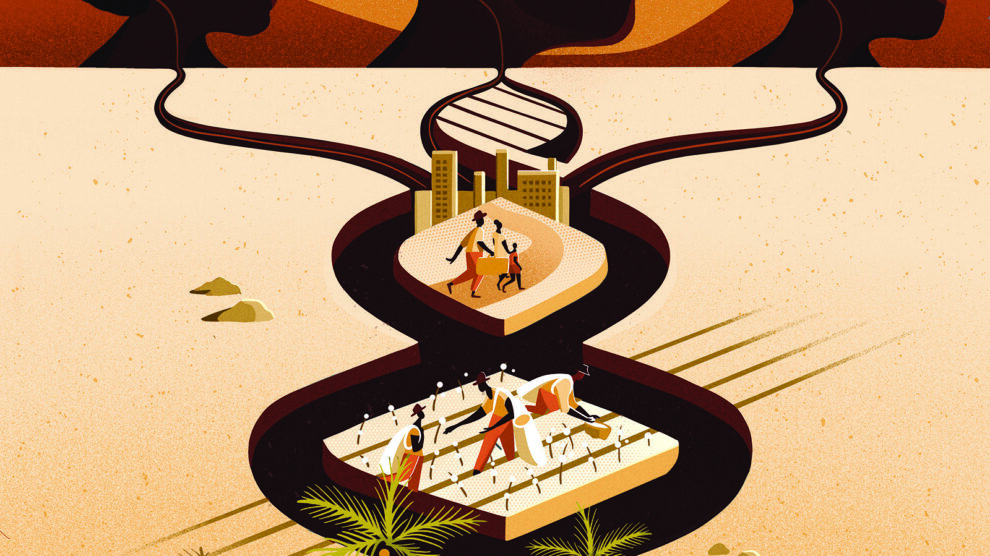Green New Deal: top-down or bottom-up?
By Sergio Belda and Victoria Pellicer
Volume 23, number 2, People’s Green New Deal

Encuentre una traducción de este artículo en español en nuestro sitio web.
From different parts of the world, we are being called upon to embrace a brand new green deal as an unassailable solution to the climate crisis. The appeal is coming from powerful actors: transnational entities, governments and political leaders (not only those with a progressive orientation),1 major newspaper headlines,2 successful financiers and leaders of large corporations,3 and intellectuals of international standing4 are calling for a great deal that will guarantee us a future that is not only green and sustainable, but truly enjoyable.
With this deal, the solutions to the problems of sustainability that we are suffering from are within our reach, right around the corner. Everyone agrees on the imagined green future we want and how to achieve it. We have the recipe, the technology, and the capacity. We just need the will, the drive, and sufficient investment.5
We are all familiar with the images of this utopian green world. The solutions that it offers delight the senses and the imagination: green, infinite, super-automated fields where fashionable, organic products grow and later fill the unlimited supermarket shelves; a world free from animal slaughter thanks to 3D-printed meat in restaurants, produced in factories and even space stations;6 autonomous electric cars filling wide, smart highways,7 finally expelled from historic city centers, which are now fully dedicated to pedestrian walkways between global franchises offering sustainable menus for all pocketbooks;8 energy produced by majestic wind turbines, bringing new prosperity to the plains of Iowa, Texas and Nebraska and new productivity to the oceans;9 in cities, huge glass skyscrapers with smart apartments on beautiful green tapestries; in the countryside, exceptionally comfortable and spacious single-family homes that are fully sustainable thanks to their intelligent design;10 at all times, unlimited access via our mobile phones to every product and service imaginable, with the peace of mind that they are offered to us without producing any waste that is not subsequently recovered (or whose environmental impact has not been incorporated into the cost and compensated for); and always the personal peace of mind from the knowledge that we are able to monitor our health twenty-four hours a day with portable devices that will not only patiently watch over us, but will also open up a huge new market.11 Images, in short, that reveal the encounter between sustainability, technology, intelligence, new markets, and prosperity. Images that should make us see the new great green deal not as a threat to our current lifestyle, but as the way to save our way of life, our planet, our individual welfare, as well as our capitalist system.12
From the centers of power, we hear that this comprehensive deal must take place in all countries and reach all people and social groups.13 Thus, difference and diversity are finally diluted in a future of sustainability, as all cultures and territories embrace the same path and the same urgent solutions.
Supporting this deal is simple. All you have to do is let those who know how to do it do it: trust in courageous policy makers with the will to act (though they come from different ideologies, we all agree on sustainability); applaud enlightened entrepreneurs who will find the right business models to accelerate change using market forces; encourage the efforts of fast food and fast fashion corporations that embrace sustainability by buying more of their products, because they will provide the necessary momentum for all of this; “like” and “follow” philanthropists, influencers, celebrities and ecologically-minded rock stars, who will be the vanguard, the voice and the face of the new times. Whoever does not accept the invitation from above to join this deal blocks the future and denies progress. It is a deal based on common sense, so how could you be against it?
There are many people who believe in the need for a new green deal of some sort, but who do not want to join yet another deal led by the powerful. Instead, these people are building an alternative deal, perhaps less visible and spectacular, but also more interesting, alive, deep, sincere, and transformative. It is a deal that is literally right around the corner, in our streets, towns, neighborhoods, rooftops, gardens, and our places of study, leisure, and work.
Itʼs a green deal, but it is not new. It is the sort of deal that people have always signed onto—to create, exchange, and consume what they need, and to understand, meet, and care for each other—but now it is taking on new forms and strategies. It is, for example, the deal signed by the people of Som Energia, a green energy consumption cooperative with more than 65,000 members, which provides electricity to more than 113,000 homes and organizations throughout Spain. The cooperative supplies energy from sustainable sources, supports local renewable energy production projects, and mobilizes and lobbies to promote the end of the oligopoly and the transformation of the energy model.14 Som Energiaʼs deal puts cooperative values, the collective, and the common at the center by generating different forms of property and shared management. It aims for political and economic decentralization by developing and disseminating financial, technical, organizational, and political means of organizing community projects for the production of energy. It places the mobilization, reflection, and commitment of the people at the center by opening up spaces for participation, exchange, and action to transform the energy model.15 It is based on solidarity, collaboration and networking, because it shares knowledge and experiences with other initiatives that are building the energy transition from below. It is an inclusive and fair deal that seeks to address situations of energy poverty and to guarantee the right to energy. Finally, Som Energia has created a democratic deal, based on the concept of the exercise of direct power by the people through the promotion of the decommodification of rights, common goods, and life.
Countless similar examples can be found in places all over the world. Cooperatives and agroecological food consumption groups in neighborhoods and villages establish relationships of trust and mutual support with local farmers in order to provide themselves with healthy and varied food without intermediaries.16 Social currencies permit people to exchange outside the market, while recognizing their own and othersʼ value.17 Cooperative housing decommercializes land and cities while providing shelter and community life.18 Mobility is enhanced through ride-sharing projects based not only on the sustainable but also on the common. Initiatives in the digital world share code, data, networks, and infrastructure, not only to make knowledge more available, but also to make its production and access freer, more open, and more democratic.19
This bottom-up deal is radically different from the one proposed by the powerful. It places not only technology at the center, but also the transformation of multiple other areas of sociotechnical and socioecological systems: relationships and patterns of organization; values and visions; production, exchange, and consumption schemes. It does not posit standardized scientific knowledge as the only valid source of knowledge, but also knowledge embedded in people and the land; not only knowledge that can give rise to a 3D printer for proteins, but also peasant knowledge that permits the production of healthy food for the community, respectful of the land and its history.
The top-down green deal is based on the unique discourse, the uncontested acceptance, the technocratic logic that nullifies politics, so it presents itself as self-evident and lacking in alternatives. In contrast, the bottom-up deal recognizes and assumes the intrinsically complex, contradictory, political, and problematic nature of social change processes. If the top-down approach places the solution and the certainty in the center, the bottom-up approach places process, doubt, and questioning in the center. If the top-down deal is based on the obedient actions of people as simple voters and consumers, the bottom-up deal has freedom (or, better, liberation) as its principle. Therefore, joining it does not imply accepting, but rather taking sides, participating, getting involved, and engaging with others.
The scientific literature has addressed the bottom-up processes that we are referring to as authentic processes of innovation, of communitarian and collective innovation, supported by the perspectives, needs, and desires of people and territories.20 Although much of what is carried out in these alternatives is by no means new, they do generate a new world on the margins of the dominant models.21 They generate alternative spaces where the way of producing, exchanging and consuming is experienced and tested under a different logic. These projects and initiatives not only dream, but anticipate, prefigure, and in fact already contain the radically different world to come. High-tech dreams, on the other hand, are empty.
Powerful actors, rather than looking with fear at the bottom-up initiatives, look on them with sympathy: for power, they are not a threat but “inspirational” practices, a source of energy and ideas that the market can incorporate (perhaps first through the vanguard action of “social entrepreneurs”). They are charmingly radical initiatives that remind us to be a little rebellious. But we know that these are two different paths: the top-down deal is not the same as the one being built by the people themselves.
In any case, a broad agreement is necessary and possible. But it must be a deal from below, a Green New Deal of the people. This does not mean an exclusive deal, but the opposite: people from politics and institutions, intellectuals, scientists, perhaps people from the world of economics, can and must be added to this peopleʼs deal. But for this to happen, other old, obscure, and ancestral deals between elites, between governments, corporations, certain scientific and intellectual circles, and other powerful actors must be broken. Only in this way can we bet on a broad deal that allows us to initiate a transition towards sustainability and justice, led by the people, that decentralizes power, democratizes social relations, and decommodifies life.
In short, as citizens, professionals, voters, scientists, managers, decision-makers, we must know what position we are taking: whether we are submissively joining the green deals proposed from above that perpetuate the system, or whether we are contributing to the creation of a Green New Deal of the people that will give rise to an alternative and radically democratic world, a world that is already possible.
References
- As a paradigmatic example, the European Commission is actively launching its European Green Deal in response to the climate crisis.
- For example, the newspaper Expansión (leader of the economic press in Spain), has supported the creation of a Green New Deal in Spain as a way of achieving energy transition by curbing the radicalism of certain groups and parties of the left. Miguel Ángel Patiño, “Teresa Ribera Puts the Brakes on Podemosʼ Energy Radicalism with her ‘New Green Deal,ʼ [in Spanish] Expansión, January 10, 2020.
- Ignacio Galán, president of Iberdrola (Spainʼs leading energy group and one of the four largest in the world), along with leaders of other large global corporations, has shown his support for the Green New Deal. See “Galán [Iberdrola] hopes that the Green Deal will encourage investment and reward the ‘green’ economy,” Europa Press, December 11, 2019.
- See, for example, Jeremy Rifkin, The Green New Deal: Why the Fossil Fuel Civilization Will Collapse by 2028, and the Bold Economic Plan to Save Life on Earth (New York: St. Martinʼs Press, 2019).
- For example, the popular intellectual Yuval Noah Harari offered a concrete investment figure: “Can you guess how much it will cost to prevent catastrophic climate change? The magic number is 2 percent. Thatʼs it. If we invest 2 percent of the worldʼs GDP in the development of technologies and infrastructure, it is enough to prevent catastrophic climate change. Guillermo Altares, “Yuval Noah Harari: ‘The Best Defence Against Pathogens Is Information’”, El País, March 22, 2020.
- See Gareth Rubin, “How Do You Like Your Beef… Old-Style Cow or 3D-printed?”, The Guardian, November 10, 2019. For a scientific article, see Arianna Dick Bhesh Bhandari and Sangeeta Prakash, “3D Printing of Meat,” Meat Science 153 (2019): 35-44.
- See Smart Road Technology: Pavimentando el camino hacia el futuro [Paving the way to the future]. Transporte inteligente. For a scientific source, see Chai K. Toh, Julio A. Sanguesa, Juan C. Cano and Francisco J. Martinez, “Avances en carreteras inteligentes para futuras ciudades inteligentes” [Advances in Smart Roads for Future Smart Cities], Actas de la Real Sociedad A 476 (2020): 20190439
- The biggest global fast food franchises have launched ambitious ads to reduce their CO2 emissions, such as McDonaldsʼs. These have been celebrated by various media. For example, Elizabeth Sturcken, “Iʼm Lovin’ It: McDonald’s Exemplifies A Sustainability Leader,” Forbes, March 30, 2018.
- Brian Merchant, “In the Future, Will Wind Turbines Be Everywhere?,” Howstuffworks
- Amory B Lovins, “How big is the energy efficiency resource?,” Editorial IOPScience
- Olshansky, S. Jay, Bruce A. Carnes, Yang Claire Yang, Norvell Miller, Janet Anderson, Hiram Beltrán-Sánchez, and Karl Ricanek. “The Future of Smart Health,” Computer 11 (2016): 14-21.
- The Financial Times recently defined the discussion on the left about the Green New Deal as a debate between saving capitalism or advancing a hidden agenda to achieve socialism: John McTernan, “The Left Must Decide Which Green New Deal They Want”, Financial Times, February 15, 2020.
- One can see, for example, the call of the World Economic Forum, in which very diverse actors supported the creation of “green deals” around the world based on the same political agenda: “Striking a Green ‘New Deal,’” World Economic Forum, recorded on January 23, 2020.
- A detailed analysis of the history, functioning and strategy of Som Energia can be found in Sebastià Riutort Isern, “Reapropiación popular de la energía en los albores de una transición incierta. A contribution from the case analysis of Som Energia” [Popular reappropriation of energy at the dawn of an uncertain transition. A contribution from the case analysis of Som Energia], Doctoral thesis, University of Barcelona, defended December 21, 2015.
- For a more detailed analysis of Som Energia as a space for learning and mobilization, see Victoria Pellicer-Sifres, Sergio Belda-Miquel and Alejandra Boni, “Learning, Transformative Action, and Grassroots Innovation: Insights from the Spanish Energy Cooperative Som Energia,” Energy Research & Social Science 42 (2018): 100–111.
- In communities around the world we find many alternative means of accessing local food in a way that is fair to producers and the environment, such as direct sale markets for peasant products, direct purchase cooperatives and vegetable box schemes. The last scheme, for example, is widely used in countries such as the United Kingdom: Rejina Sabur-Cross, “Should I get a veg box?,” BBC Good Food. These experiences are also generating networks in multiple places. For example, in Italy, Genuino Clandestino is a network of communities and farmers that develop alternative practices, such as different forms of direct sales or participatory certification schemes (based on the direct relationship between producers and consumers), an alternative to exclusive official labels: A. Koensler, “Reinventing Transparency: Governance, Trust and Passion in Activism for Food Sovereignty in Italy,” Ethnologia Europaea [Journal of European Anthropology] 48 (2018): 50-66.
- There are thousands of social or community currencies in the world. They have in common that they are neighborhood monetary systems based on trust and reciprocity, although there are very different types. Among them, time banks are based on exchange, within which the currency is the time spent providing some service to another person; barter networks generate their own currencies for exchange; local currencies can be “bought” with legal tender and are more oriented to supporting local neighbourhood trade. See Geoff Milgan, “How Community Currencies Could Help Rebalance Our Economy,” The Guardian, June 28, 2016.
- n several countries, forms of construction and shared ownership of housing that facilitate access and prevent speculation have become very ambitious. For example, in Uruguay approximately 30,000 families (about 2.65 percent of the population) live in housing built by the cooperative movement. This has generated an extensive means of access to housing for the popular classes, in addition to generating processes of mutual aid, inclusion, and participation. See Jennifer Duyne Barenstein and Michael Pfister, “The Professionalization of a Social Movement: Housing Cooperatives in Uruguay,” Built Environment 45 (2019): 382-397. In Europe, we also find very celebrated examples such as the Andel model in Denmark (under whose regime 30 percent of the housing in Copenhagen works, although it is currently undergoing profound changes towards a more elitist access model) and the Mietshäuser Syndicat in Germany, of less quantitative importance but more strongly self-managed: Lacol and The Invisible City. Habitar en Comunidad (Madrid: La Catarata, 2018).
- This movement would include, for example, the hacker environment, composed of all individuals who use technology and computers from the perspective of making information and knowledge available to anyone, with actions that can range from the creation of an operating system to making information of interest available to the public. As Pecka Himanenm points out in his famous work The Hacker Ethic and the Spirit of the Information Age (Random House e-books, 2001), the hacker movement has developed its own ethics based on social value, free access, transparency, openness, and commonality.
- See, for example, Sergio Belda Miquel and Victoria Pellicer Sifres (eds.), Innovación social colectiva: Experiencias para la transición a la sostenibilidad desde la ciudadanía organizada [Collective social innovation: Experiences for the transition to sustainability from organized citizenship] (Barcelona: Icaria, 2019), or Gill Seyfang and Adrian Smith. “Grassroots innovations for sustainable development: Towards a new research and policy agenda,” Environmental Politics 16.4 (2007): 584-603.
- For a theoretical and empirical analysis on the question of innovation and justice in these experiences, see Sergio Belda Miquel, Victoria Pellicer Sifres and Alejandra Boni, “Exploring the Contribution of Grassroots Innovations to Justice: Using the Capability Approach to Normatively Address Bottom-Up Sustainable Transitions Practices,” Sustainability 12, no. 9 (2020): 3617.





